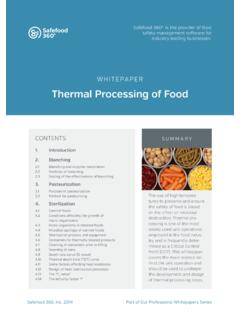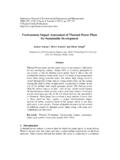Transcription of Electricity production in Sweden - IVA
1 Electricity production in SwedenIVA s Electricity Crossroads project Royal Swedish Academy of Engineering Sciences, Box 5073, SE-102 42 StockholmTel: +46 (0)8 791 29 00 Fax: +46 (0)8 611 56 23E-mail: IVA-R 489 ISSN: 1102-8254 ISBN: 978-91-7082-920-8 Author: Karin Byman, IVAP roject manager: Karin Byman, IVAE ditor: Camilla Koebe, IVAL ayout: Anna Lindberg & Pelle Isaksson, IVAC over photo: SiemensThis report is also available for download at IVA s Summary ..52. Introduction ..63. Electricity production in Sweden ..74. Renewable energy sources ..9 Hydropower ..9 Wind power ..11 Solar power ..13 Wave and offshore power production .
2 15 Tide power plants and plants in flowing water ..15 Geothermal energy generation ..165. Electricity production based on fuel combustion ..17 Coal power plants ..18 Gas turbines ..19 Combined-cycle power plants ..20 CHP biofuels ..20 CHP in industry ..22 CHP waste ..23 Gas engines ..246. Nuclear power plants ..25 Nuclear power fission ..25 Fusion ..287. Economics and the investment climate ..29 Wind power ..31 Solar cells ..31 Conventional power plants ..32 Gas turbines ..32 Combined-cycle power plants ..32 CHP in district heating systems ..32 CHP in the forest industry ..33 Nuclear power.
3 338. Appendix ..34 Footnotes ..34 References ..34 GLOSSARYA lpha value The ratio between Electricity production and heat production in a combined heat and power (CHP) plant, calculated as Electricity production divided by heat load When a power plant is operating at a lower production level than its installed capacity allows. Power balance To maintain a stable frequency of 50 Hz, there must be a balance between production and usage. If this is out of balance, the frequency in the system will increase or efficiency The efficiency of a power plant s Electricity generation in relation to the amount of energy used to operate it.
4 Usually this is the percentage of the power plant s energy input that can be used in the form of electrical energy in a grid outside the plant. Gross efficiency means how much electrical energy the generator provides (some of which is used for the power plant itself ) and net efficiency means the energy used outside the power plant, in relation to the energy input. fluidised bed A combustion process where fuel in the form of particles is mixed with sand and set in motion using powerful air flows from underneath. There are two main types: bubbling fluidised beds (BFB) or circulating fluidised beds (CFB). This technique creates a very effective and efficient combustion process.
5 Frequency The Nordic power grid has an alternating current frequency of 50 Hz. Frequency indicates the number of periods per second. There is a definite relationship between a generator s rotational speed and the frequency generated. Combined-cycle power plant A plant where a gas turbine is combined with an exhaust gas boiler and a steam turbine. Generator Kinetic energy is converted in a generator into electrical energy when a copper spool rotates in a magnetic field. Intermittent power Electricity production technology where the output cannot be planned, but the maximum possible output of which is determined by the prevailing weather conditions, for example wind and solar.
6 Often also called weather-dependent or volatile power. Open cycle The simplest type of gas turbine where combustion gases expand in a turbine which drives a generator. Baseload power Electricity production technology the output of which can be planned regardless of the weather conditions, such as nuclear power, gas turbine, CHP and hydropower technology. Primary control Reserves (hydropower) activated automatically in response to deviation from the Hz frequency. The reserves are activated between and Hz and between and Hz. Balancing energy Electricity generation technology that can be adapted increased or decreased according to energy requirements, for example hydropower and CHP.
7 Balancing energy market A market where there is bidding for positive and negative balancing of the energy used in Sweden s national grid during operating hours to maintain a balance and handle flows and bottlenecks in the grid. Energy balancing resource production or use that can be adjusted during operation for the purpose of achieving a balance between production and consumption. Reserves, reserve power, power reserves Reserves are a collective energy balancing resource used to ensure balanced power in the grid and by extension operational reliability and quality in energy delivery. Inertia Inertia occurs in all rotating machines (generators and engines) that are directly connected to a synchronous system.
8 If an imbalance arises between production and consumption the rotational energy slows down the frequency adjustment. Inertia also occurs in wind turbines, but special technology is needed in order for the system to benefit from it. This is so-called synthetic inertia. Total efficiency Some power plants produce both thermal energy in the form of steam or hot water for consumers, while also producing electrical energy. The total efficiency is the percentage of the energy supplied that can be used in the form of heat energy and electrical energy, in the direct vicinity of the In a turbine, kinetic energy in a liquid or gas is converted into mechanical work in the form of a rotating turbine axle.
9 Operating time A theoretical calculation of the number of hours a power plant would need to operate at full power to generate the same amount of energy that the plant actually generates, but with a variable load, total energy production divided by installed capacity. Also called equivalent full-load hours or duration. Heat market A CHP plant requires a market/destination for the cooled heat energy it generates. This is normally a district heating system or an industrial process. Enthalpy (heat) of vaporisation The amount of energy consumed in order for liquid at a certain pressure and at the corresponding boiling point to be converted into steam.
10 The same energy can be recovered if the steam is condensed into liquid, but is then called enthalpy (heat) of SummaryStructural changes are happening on the Electricity markets all around Europe where centrally located power plants are being replaced by smaller, more dispersed ones. In Sweden the trend is most evident in the fast growth of wind power production , while nuclear power is becoming less profitable. The big challenge in the Electricity market in Swe-den going forward is how to manage an increasing share of variable and intermittent power generation in the system at the same time several nuclear reac-tors are decommissioned over the next 10 15 years.



